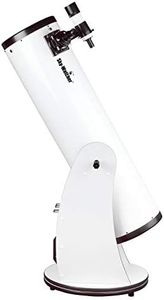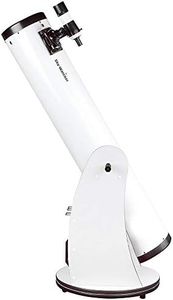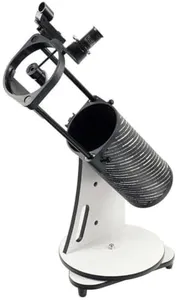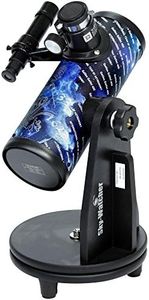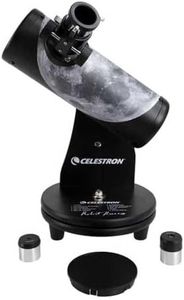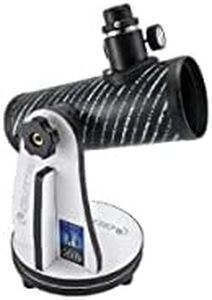We Use CookiesWe use cookies to enhance the security, performance,
functionality and for analytical and promotional activities. By continuing to browse this site you
are agreeing to our privacy policy
8 Best Dobsonian Telescopes
From leading brands and best sellers available on the web.By clicking on a link to a third party's website, log data is shared with that third party.
Buying Guide for the Best Dobsonian Telescopes
Dobsonian telescopes are a popular choice for amateur astronomers because they are simple to use, offer large apertures for the price, and give beautiful views of the night sky. When choosing a Dobsonian telescope, it’s essential to consider what you want to observe, where you'll use the telescope, and how easy it will be to move and store. Focusing on the right combination of size, ease of use, and portability will help you enjoy stargazing without getting overwhelmed.Aperture (Objective Diameter)The aperture refers to the diameter of the telescope's main mirror, and it determines how much light the telescope gathers. This is crucial because more light means brighter and sharper images, especially of faint objects like nebulae and galaxies. Dobsonian telescopes can have apertures from about 6 inches for more portable models up to 16 inches or more for larger ones. A small aperture (6–8 inches) is great for portability and simple views of the Moon and planets. Medium (8–10 inches) lets you see fainter deep-sky objects. Large (12+ inches) brings in even dimmer, more distant celestial objects. If you mostly observe from darker locations and want to chase faint fuzzies, a bigger aperture will be rewarding. For urban or backyard use and easy transport, a smaller aperture is easier to handle.
Focal Length and Focal RatioFocal length is the distance the light travels within the telescope, and the focal ratio (written as f/number like f/5 or f/8) is the focal length divided by the aperture. This affects the telescope's magnification and its field of view. Faster focal ratios (like f/5) give wider views, making it easier to observe large star clusters or nebulae. Slower ratios (like f/8) give higher magnification for detailed views of planets and the Moon. Most Dobsonians have focal ratios between f/4 and f/8. Choose a lower focal ratio for wider sky views and faster, brighter images—ideal for deep-sky observing—while higher focal ratios are better if you want to look at planets.
Mount Type and MotionDobsonian telescopes use a simple, alt-azimuth mount that lets you move the telescope up and down and left to right. This makes them intuitive and sturdy, perfect for beginners. Larger telescopes can get heavy, making motion less smooth. For easier observing, look for features like Teflon pads or ball bearings in the base, which make tracking objects smoother. If you plan to set up and observe quickly, a standard Dobsonian mount with smooth movement is ideal.
Portability and WeightDobsonians come in a range of sizes and weights, and larger apertures mean heavier and bulkier telescopes. If you need to store your telescope or transport it to your observing location, consider how comfortable you are moving a 40–80 pound instrument. Some Dobsonians are 'truss tube' designs that can be disassembled for easier travel. If you have a permanent spot, a heavy, rigid tube is fine; if not, look for a design that balances aperture with portability.
Ease of CollimationCollimation is the alignment of the mirrors in the telescope, and all Dobsonians need this from time to time to perform at their best. Some Dobsonians make collimation easier with adjustable screws and included tools. If you’re a beginner, pick a model that has easy access to collimation controls and provides clear instructions. For those who want less maintenance, a design with well-designed mirror supports will keep collimation easier to manage.
Finder Scope TypeThe finder scope helps you aim the telescope. Dobsonians typically use simple 'red dot' finders or small optical scopes. Red dots are quick for locating bright objects, while optical finders with a low magnification give a closer view of star fields. If you struggle to find faint objects, an optical finder may help, while red dots are faster for casual, bright object viewing.
